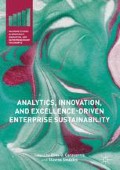Abstract
There is an irreversible trend toward the criticality of big data analytics’ capability and exercise thereof so that rather than exclusive use of traditional ‘data-driven decision-making’ approaches, sustainable—organizational—excellence will often demand focus on more computationally intensive data and information generation, collection, extraction, and interpretive procedures that—when added to traditional data-driven methods—yield the area of sustainable enterprise excellence referred to as enterprise intelligence and analytics.
Access this chapter
Tax calculation will be finalised at checkout
Purchases are for personal use only
References
Benner, M.J., and M.L. Tushman. 2003. Exploitation, exploration, and process management: The productivity dilemma revisited. Academy of Management Review 28(2): 238–256.
Ceri, S., G. Gottlob, and L. Tanca. 2012. Logic programming and databases. Heidelberg: Springer Science & Business Media.
Chen, Hsinchun, Roger H.L. Chiang, and Veda C. Storey. 2012. Business intelligence and analytics: From big data to big impact. MIS Quarterly 36(4): 1165–1188.
Galbraith, J.K. 2012. Inequality and instability: A study of the world economy just before the great crisis. New York: Oxford University Press.
Gibson, C.B., and J. Birkinshaw. 2004. The antecedents, consequences, and mediating role of organizational ambidexterity. Academy of Management Journal 47(2): 209–226.
Gunday, G., G. Ulusoy, K. Kilic, and L. Alpkan. 2011. Effects of innovation types on firm performance. International Journal of Production Economics 133(2): 662–676.
He, Z.L., and P.K. Wong. 2004. Exploration vs. exploitation: An empirical test of the ambidexterity hypothesis. Organization Science 15(4): 481–494.
Joshi, K.D., L. Chi, A. Datta, and S. Han. 2010. Changing the competitive landscape: Continuous innovation through IT-enabled knowledge capabilities. Information Systems Research 21(3): 472–495.
LaValle, S., E. Lesser, R. Shockley, M.S. Hopkins, and N. Kruschwitz. 2011. Big data, analytics and the path from insights to value. MIT Sloan Management Review 52(2): 21.
Nickerson, J.A., and T.R. Zenger. 2004. A knowledge-based theory of the firm—The problem-solving perspective. Organization Science 15(6): 617–632.
Provost, F., and T. Fawcett. 2013. Data science and its relationship to big data and data-driven decision making. Big Data 1(1): 51–59.
Reinmoeller, P., and N. Van Baardwijk. 2005. The link between diversity and resilience. MIT Sloan Management Review 46(4): 61.
Author information
Authors and Affiliations
Corresponding author
Editor information
Editors and Affiliations
Copyright information
© 2017 The Author(s)
About this chapter
Cite this chapter
Sindakis, S. (2017). Applying Data Analytics for Innovation and Sustainable Enterprise Excellence. In: Carayannis, E., Sindakis, S. (eds) Analytics, Innovation, and Excellence-Driven Enterprise Sustainability. Palgrave Studies in Democracy, Innovation, and Entrepreneurship for Growth. Palgrave Macmillan, New York. https://doi.org/10.1057/978-1-137-37879-8_11
Download citation
DOI: https://doi.org/10.1057/978-1-137-37879-8_11
Published:
Publisher Name: Palgrave Macmillan, New York
Print ISBN: 978-1-137-39301-2
Online ISBN: 978-1-137-37879-8
eBook Packages: Business and ManagementBusiness and Management (R0)

